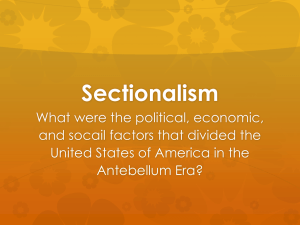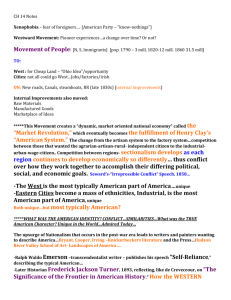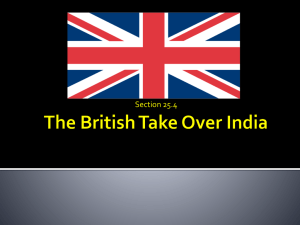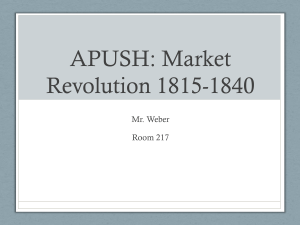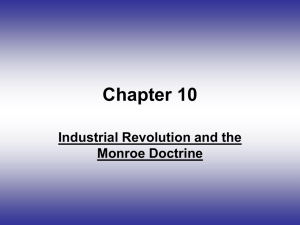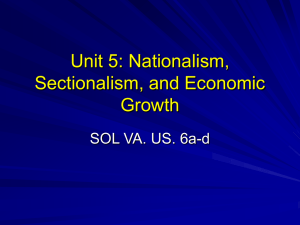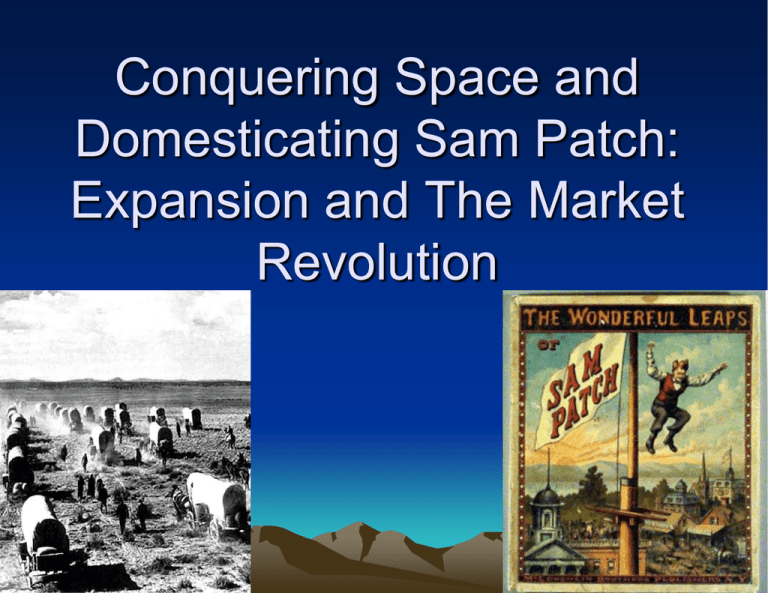
Conquering Space and
Domesticating Sam Patch:
Expansion and The Market
Revolution
• Discuss the impact of territorial expansion on national unity
between 1800 and 1850. (97)
• The Jacksonian Period (1824-1848) has been celebrated as the
era of the “common man.” To what extent did the period live up
to its characterization? Consider the following in your response:
Economic development, Politics, Reform movements (01)
• In what ways did developments in transportation bring
about economic and social change in the US in the period
1820 to 1860? (03)
• Developments in transportation, rather than in manufacturing
and agriculture, sparked American economic growth in the first
half of the nineteenth century. Assess the validity of this
statement. (89)
• In the period 1815 to 1860, improvements in transportation and
increased inter-regional trade should have united Americans,
but instead produced sectional division and finally disunion.
Discuss with reference to the impact of improved transportation
and increased inter-regional trade on the Northeast (New
England and Middle Atlantic states), the South, and the West.
(80)
• Discuss the impact of the “transportation revolution,” 1820 –
1860, on the U.S. (73)
I. Population Growth and
Westward Expansion
• Am pop. doubled every 23 years
– 1790: 4 million
1810: 7 million
• Overwhelmingly agrarian: to maintain
standard of living, had to improve ag.
tech or double acreage
– Tech not keeping pace westward
movement
• 1790-1810: needed to bring in as much land as
had in all period before
– 1810: 1 in 7 West of Appalachians
– 1840: 1 in 3
• Louisiana Purchase vital (doubles size US)
• Most migrants native born, lower middle class
• Tend to move due West (NE to Midwest, S to
lower Midwest and SW)
• Fed. gov wanted rapid settlement for $: required
full payment in cash speculators buy up vast
tracts
• Squatters doing most of farming pre-emption
law (1841): allows squatters to buy at low cost
Images of Life
• 1) “Little House on the Prairie”:
independent, self-sufficient, isolated
homesteads but brought together
for communal activities
• 2) Clint Eastwood: instability,
constant motion no real
community; fed by “strip-farming”:
belief that resources unlimited;
general rudeness and violence
– Reality somewhere in between: most
worked/wanted to replicate old lives
II. Dispossession of Indians
A. Legacy of War of 1812
• Collapse of Tecumseh’s pan-Indianism
(Battle of Thames, War of 1812)
Indians no longer able to effectively
resist white settlement
• 1817-18: First Seminole War: Andrew
Jackson invades Florida to attack
Seminoles Adams-Onis Treaty ceding
Florida to US
– AJ exceeds order: hunts down Indians
B. Five Civilized Tribes and the
Trail of Tears
• Creek, Choctaw, Cherokee, Chickasaw,
Seminole: largely assimilated
• Farmers, built schools, developed alphabet,
published newspapers, conversion, tribal
Constitution based on US
• Integration into market economy
dependence (debt + alcohol) facilitates
removal (sell lands, socio-cultural disruption,
pop decline)
– War, disease, malnutrition 50% decline
• Logic of Fed Indian policy
should have left alone, but
own valuable lands + gov’t
protects/supports whites
(even illegal settlers)
• 1830: Georgia throws them
out
• AJ: Removal Bill of 1830:
resettle all tribes west of
Miss. racial rationale
– 1824: Monroe suggests
removal as protection
Indians
– Not just AJ: before + after
• Cherokees sue Cherokee Nation v. Georgia (1831)
and Worcester v. Georgia (1832): Marshall rules
Indians cannot be removed
• AJ: “John Marshall has made his decision: now let him
enforce it.”
• 1831-1838: Indians removed
• 1838: Cherokee Trail of Tears: forced march to
Oklahoma ¼ die
• 1844: 3 of 4 Indians removed to West
III. Transportation Revolution
• Poor transportation obstacle to migration:
cost transport wheat KY to NYC 3x price
of sale
– Cheaper ship PhilaLondon than
PittsburghPhila
• 1815: John C. Calhoun (SC): “Let us
conquer space”
• 4 Major stages
A. Turnpikes
• Paved roads, built by states + private
companies
• Most connected Eastern cities
– But, National Road
• Poor quality, expensive
B. Steamboats
• Esp. impacted Miss +
tributaries (Ohio)
• Transport at 1/10 cost
flatboats
• Dangerous: snags,
explosions, run
aground
C. Canals
• Boom 1820s + ’30s
– Erie Canal (1825): Buffalo to Albany; NY Gov. DeWitt
Clinton
– Major expenditures by states: 3/4 of $200 million from
1815-1840s; far more than Fed
• Cost reduced 20¢ to 1¢ (1 ton Buffalo NYC)
• Eventually water system linking NYC to New Orleans
• Enormous impacts
– Canal towns:
industry, pop.
growth, social
change, alcohol
– Midwest: greater
access resources +
needs eastern
industry +tech
deforestation
• Canal boom short
lived: overtaken by…
D. Railroads
• 1830: National system begun Baltimore
and Ohio RxR (13 miles)
• 1840: 3328 miles (2x track in Europe)
• 1850: 9000 miles (majority in N)
• Biggest jump transport exp. (speed) in
Am. history: 4 mph to 40/50
• Annihilated space + time (time zones)
• Uniquely adapted to size US
IV. Market Revolution and the
Machine in the Garden
A. Agrarian Revolution
• Transport rev. bound growing nation
econ. transformation: western farmers
switch subsistence to commercial:
specialization, orient to profit, mechanize
– NE + Mid Atlantic: terrain unable use
machines move West, move cities, or dairy
+ fruit farmers
– 1820: 1/3 all food for market; 1850: 50+%
• South: cotton gin (1793) + northern industry
(1820s) cotton
• South most tied inter’l markets, but least
affected internally: depended on outsiders for
marketing + financing, capital tied up in land and
esp. slaves colonial economy
• Southerners profit motivated, but slavery made
“peculiar system”
Ambivalence to Revolution:
• Huck Finn: steamboat destroys idyllic life on raft
• Escape to Walden Pond: Henry David Thoreau
and Transcendentalists
• Death knell of Jeffersonian yeoman farmers
– 1800: 6 of 7 workers farmers
– 1860: 50% farmers
– 1990: 1.6%
• But, “machine happy”: boom in “labor saving
devices” (mechanical apple peelers)
B. The American System
• “Borrowed” early British
technology
– 1790 Samuel Slater textile mill
• Eli Whitney: precision
machinery for interchangeable
parts (firearms, cotton gin)
American system: machines
make machines consumer
items (clocks, watches, sewing
machines)
• Mechanized industry social
restructuring: replace “putting
out” system w/centralized
factory
• Francis Cabot Lowell (1813),
power loom (water): Lowell,
Mass.
– Boston Manufacturing
Company: Waltham, Mass.
• 1817: 4 million yards cotton
cloth; 1840: 323 million
• 1840: 80,000 workers (50+%
women)
– Huge impact on South King
Cotton
C. Taming Sam Patch
• Difficulty of factory: pre-industrial sense of time
– 1st clocks only had hour hand; 1830s 1st massproduced home clocks
• Rhythmic, seasonal, nature, task not clock
Saint Monday
• Rich variety of entertainments (that then
affected work): Alcohol, dancing, athletics,
horse races, circuses, magic, balloons, Sam
Patch
– Left work when these options available
• Patch a highly-skilled mill worker,
jumped off of things: bridges, flag
poles, waterfalls (Niagara twice)
• Working class hero: “possession of
an art made a man independent and
useful and, therefore, the sovereign
equal of any other man”
• Middle class threat: reason to fear full
democracy, undermined beauty of
nature (Hudson River School),
passed laws against jumping
– 6 November 1829: Upper Falls of the
Genesee in Rochester, New York (100
ft), accompanied by a pet bear
– Friday 13th: same jump, no bear, dies,
age 30
• Changed through: incentives + institutions:
church (2nd Great Awakening: temperance,
hard work, perseverance), schools (tech., time
discipline), local gov’t (police)
• 1827, Lynn, MA: Society for the Promotion of
Industry, Frugality, and Temperance: hiring
pact, boycotts, by-laws, truant officers,
ministers alter personality entire class to
further capitalist goals
• Successful? 2 measures: 1) liquor and 2)
babies
– 1800-1860: avg. # kids 7 5.2
– Less sex (no new birth control), less alcohol, kids
econ drain in industrial society, some honestly
converted

